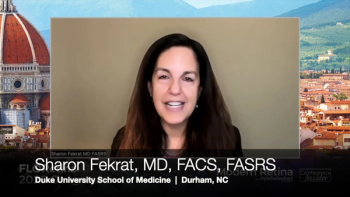
Q&A: Arshad Khanani discussed the open-label extension of the GATHER2 trial
Arshad M. Khanani, MD, MA, FASRS, of Sierra Eye Associates in Reno, NV, presented new findings from the GATHER2 open-label extension trial, providing the first look at 3-year outcomes with avacincaptad pegol in patients with geographic atrophy (GA).1 His presentation, delivered during Retina Subspecialty Day at the American Academy of Ophthalmology 2025 annual meeting, October 17–20 in Orlando, FL, builds upon the 2-year GATHER2 study. Khanani shared some of the highlights from the open-label extension trial in an interview with the Eye Care Network.
Note: The following conversation has been lightly edited for clarity.
Ophthalmology Times Europe: Dr Arshad Khanani, is presenting some interesting data at this year's American Academy of Ophthalmology. We have the 3-year results from the GATHER2 open-label extension trial. So we'd love to hear a little bit about what you've learned, some of the early outcomes or highlights.
Arshad M. Khanani, MD, MA, FASRS: Thank you for inviting me to discuss my first-time results talk at the AAO Subspecialty Day 2025, where I presented the data from the open-label extension of the GATHER2 trial. As you know, GATHER2 trial was a pivotal study, 2-year study that showed that avacincaptad pegol, or ACP, slowed down GA growth compared to sham. The primary endpoint was met at 1 year. And of course, ACP, or avacincaptad pegol is FDA-approved for the treatment of geographic atrophy. In the open-label extension, so this started after the 2-year GATHER2 study ended, all patients had an opportunity to roll into the open-label extension and in this study, patients who are on avacincaptad pegol monthly or every other month in the prior year were now given ACP monthly for 18 months, and the patients who were treated with sham injections for 2 years also had the opportunity to receive ACP monthly for 18 months. I presented the first-time results from the 18 month open-label extension giving us 3-year plus data for the overall program. The key findings from this data set is that the retention was very good: 85% of patients who enrolled in open-label extension finished open-label extension, and the key results are the efficacy and the safety data from from open-label extension. For efficacy, obviously there is no sham control, so we compared it to a projected sham so when you look at patients who were on ACP before open label extension now received ACP for another 18 months, that resulted in 40.5% reduction in GA lesion growth with continuous use of ACP in that group compared to projected sham. The patients who were on sham for 2 years after crossover, we saw that ACP reduced GA growth by 37.1%. What we saw was the benefits started early, and it kept increasing in those patients who were on sham before. The bottom line is this data set shows that earlier treatment with ACP demonstrated increasing efficacy in slowing GA lesion growth over time. Those are the efficacy findings. Of course, open-label extension was designed to look at safety, and when we look at safety, there are no new safety signals that were seen in the open-label extension compared to the GATHER2 2-year data set. ACP was well tolerated, and there were no cases of retinal vasculitis or occlusive retinal vasculitis. In conclusion, we see the benefit of ACP in patients with GA with continuous use. The efficacy continues to increase, and patients who are on sham group also saw a benefit after crossing over to ACP.
OTE: That's a perfect summation, and I'm just kind of curious, how do you anticipate the findings from GATHER2 influencing treatment patterns for everyday clinical practice?
Khanani: I think that's the important question. This data set shows that earlier treatment and continuous treatment is better for patients with GA, in slowing GA down. I think as a clinician, I'm inclined towards treating patients as early as I can, so that I can slow down the disease over time, so we can preserve more retinal tissue if we started early. That's the bottom line is yes, starting late will also help slow it down, but starting early is much better than starting late.
OTE: And then what do you envision as maybe the next steps in your research and the development of further treatments for GA?
Khanani: Obviously, avacincaptad pegol is FDA-approved. I think, as a community, we continue to generate real-world data. Even in the real-world data set that has been presented by many of my colleagues to date, we have not seen any new safety signal with ACP, which is very, very reassuring. In terms of the GA as a field, there are multiple shots on goal in terms of new treatments that are looking at new mechanism of action, gene therapy for GA, their program is systemic medication, also with oral pills, and, of course, targeting lipids. There's a lot going on in the space, but obviously our best options right now are the approved drugs, which is ACP, as well as pegcetacoplan. So those are the 2 approved drugs right now. I think this data set for ACP is very powerful in terms of showing consistent safety and then increasing efficacy over time.
OTE: Is there anything else that you'd like to add that you'd like to add that you feel is really important for our audience to know or just be aware of in terms of your presentation, or in geographic atrophy treatments in general?
Khanani: I think the key is that we are so used to seeing a 'wow' effect of treatment when we are using drugs to treat retinal vascular diseases like neovascular AMD, DME, retinal vein occlusion, because we have a very good target in VEGF. Here GA is a multifactorial disease, age, genetics, medical issues, society, smoking, and complement hyperactivation. So we are targeting complement hyperactivation with ACP, which is a C5 blocker. We're doing our best on things that we can control. I think as a community, we're used to seeing much better efficacy, a 'wow' effect on OCT. This is very different. This is more like slowing down the worsening. Obviously, we have the side effects of increased pressure, which goes down with observation in most cases, and small increased risk of CNV or wet AMD. As a community, I don't think we have embraced GA drugs like we embraced anti-VEGF because of the 'wow' effect. My conclusion from this is that both programs—ACP as well as pegcetacoplan—have shown that early treatment with continued treatment leads to better slow down of geographic atrophy. I hope this data set convinces the physicians who are not treating GA patients that there is value for our patients. Obviously, the biggest challenge has been not seeing a functional benefit, but we are protecting retinal tissue, which all of us know that is saving photoreceptor cells, but functional benefit has been difficult to show in clinical trials because of the patient population we are looking at, which is quite advanced. So hopefully this day is data set with ACP helps clinicians use ACP in their practice with confidence, because the safety is consistent and efficacy increases over time.
Newsletter
Get the essential updates shaping the future of pharma manufacturing and compliance—subscribe today to Pharmaceutical Technology and never miss a breakthrough.













































